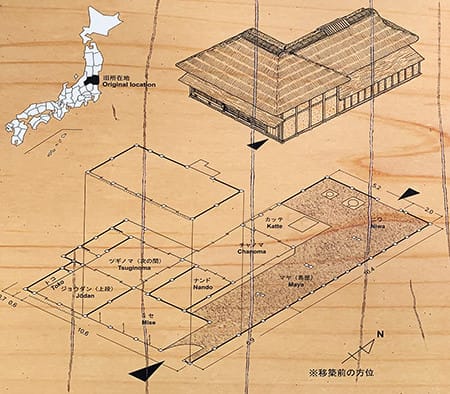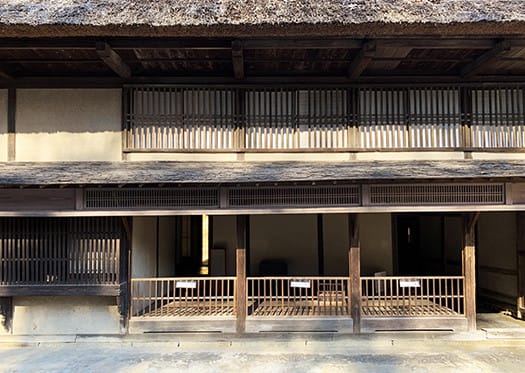



本日からふたたび「日本人のいい家」シリーズ古民家研究です。
コロナ禍で現代住宅の取材機会はデリケートになっていることもあり、
そういった取材機会はわたしのような立場では減少気味。
しかしわたしはあくまでも住宅の空気感をいちばん大切にしたい。
ということで過去撮影の古民家写真が大量にあるのを再整理したかった。
コロナ禍が民族の住宅文化探求に繋がっている次第。いい機会です。
東北地域は古くから「馬産」が盛んだった。
「戸」という律令政府の地方行政単位は、地域産業として米作に依らないで
馬産が主要な日本社会の中での経済位置を占めていたことを表すとされる。
律令制での「戸」の扱いについては、
〜日本においては律令制以前の6世紀以降に、ヤマト王権(大和朝廷)が
伝統的な部に属しない氏族を組織・掌握するため部分的に採用されたと考えられ、
大化の改新後に新羅の制度などを取り入れる形で施行されたと考えられている。
〜(Wikiの記述)。東北北部はながく稲作に適さなかった地域で「戸」という
戸籍上の単位が採用されたように思われる。
一方の馬産について青森県軽種馬生産農業協同組合のHPには以下の記述。
〜東北地方の馬に関する記録は「続日本記」養老2年(718年)の記事が初見。
当時、陸奥と呼ばれた青森地域には、すでに多くの馬が飼養されていたことが
他の文献にも記述されるが、この地域が馬産地として歩みだすのは平安初期、
朝廷が馬産の重要性を認めこの地域の産馬の持ち出しを禁じた頃からである。
武士勢力が国内に現れ始めたのもこの時期からで源平盛衰記に記される
寿永3年(1184年)の宇治川大合戦で活躍した2頭の南部馬によって、
この地域の馬の優秀さは以後の武士たちに広まっていった。
鎌倉幕府を築いた源頼朝も南部馬に大きな関心を持っていたひとりで、
奥州藤原氏討伐後甲斐の南部光行に糠部(八戸地域)を治めさせたのも、
馬に精通していたからだったという。(頼朝と馬はいくつか名馬にまつわる物語が
舞台作品のテーマにもなっている。)南部一族は光行から30年後の実光の時代、
一戸・七戸・四戸・九戸の4地区にそれぞれ行朝・朝清・宗朝・行連の4兄弟を配し
特に馬産に力を注いだ。 これが現在の馬産の基盤になったといわれている。〜
古代から中世にかけヤマトによる東北制圧が主要な歴史の動因になったけれど、
産金と、軍事物資の最たるものとしての馬が奥州の位置を決めたと思える。
戦国期での鉄砲にも匹敵する物として馬産はあったのかも知れない。
その馬産の流通経路について、結構重要な経済要因だったはずだけれど、
各地に残る「馬市」の様子が知られる程度で具体的な姿が見えにくい。
そんななかで、この福島市近在に残っていた「馬宿」は興味深い。

この古民家は「赤浦屋」と呼ばれていた馬宿。
馬宿とは、博労など馬を運搬して商いをするひとびとのための旅宿。
当然、馬たちも土間で休ませ、人間は座敷で寝たと言うこと。
博労とは売買の責任者であり、通常の人足仕事にあたる人は2階に泊まりますが、
ここではたまに宿泊の武士と同等で1階の座敷で泊まっていたとされています。
街道に面した側は店舗としての仕様で、土間が続く開口部から奥に
長く旅宿機能の空間が展開しています。
かれらの目的地はここから約30kmほどの「本宮」での馬市だったとされる。
はるばる南部地域から旅してきた一行にとって、あともう少しの立地の旅宿。
写真の右側土間に馬が寝て、左手側で人足たちが食事したりした。
さまざまな人間がここを通り過ぎた空間記憶が呼び覚まされる古民家。
数日にわたって、その馬宿空間を解析してみたいと思います。
The English version is here. ⬇
[Oshu Kaido / Fukushima Horse Inn / Good Japanese House ⑱-1]
Horse production occupies a large position in Japanese history as a military combat force or as an agricultural machine. An old folk house that conveys that spatial memory.・ ・ ・
From today, I will study the "Good Japanese Houses" series of old folk houses again.
Due to the corona sickness, the opportunity to cover modern houses has become delicate.
Such interview opportunities are on the decline from a standpoint like me.
However, I want to value the atmosphere of the house most.
So I wanted to reorganize the large number of old folk house photographs taken in the past.
As soon as the corona wreck has led to the quest for ethnic housing culture. This is a good opportunity.
"Horse products" have been popular in the Tohoku region for a long time.
The local administrative unit of the Ritsuryo government called "door" does not depend on rice cultivation as a regional industry.
It is said to indicate that horse production occupies an economic position in major Japanese society.
Regarding the treatment of "doors" in the Ritsuryo system
~ In Japan, after the 6th century before the decree system, the Yamato kingship (Yamato court)
It is believed that it was partially adopted to organize and control clans that do not belong to the traditional department.
It is believed that it was implemented in the form of incorporating the Silla system after the Taika Reform.
~ (Wiki description). Northern Tohoku is an area that was not suitable for long-term rice cultivation and is called a "door".
It seems that the unit on the family register was adopted.
On the other hand, the website of Aomori Prefecture Light Horse Production Agricultural Cooperative has the following description.
-For the first record of horses in the Tohoku region, see the article in "Nihonki", 2nd year of Yoro (718).
At that time, many horses were already bred in the Aomori area called Mutsu.
As described in other literature, it was in the early Heian period that this area began to be a horse-producing region.
It was around the time when the imperial court recognized the importance of horse production and banned the removal of horses from this area.
It was from this time that the samurai forces began to appear in Japan, and it is recorded in Genpei Jōsuiki.
By two southern horses who played an active part in the Ujigawa Great Battle in Juei 3 (1184)
The excellence of horses in this area spread to the samurai who followed.
Minamoto no Yoritomo, who built the Kamakura Shogunate, was also one of the people who had a great interest in southern horses.
After the subjugation of Mr. Fujiwara Oshu, it was also the reason why Mitsuyuki Nanbu of Kai ruled Nukanobu (Hachinohe area).
He was familiar with horses. (Yoritomo and horses have some stories about famous horses
It is also the theme of the stage production. ) The Southern Clan was in the real light era, 30 years after the light line.
Four brothers, Gyocho, Chosei, Socho, and Gyoren, are assigned to each of the four districts of Ichinohe, Shichinohe, Yoto, and Kunohe.
Especially focused on horse production. It is said that this became the basis of the current horse production. ~
From ancient times to the Middle Ages, Yamato's control of Tohoku was a major historical motive.
It seems that gold production and horses as the best military supplies have determined the position of Oshu.
Horse production may have been comparable to the guns of the Warring States period.
It must have been a fairly important economic factor for the distribution channel of horses,
It is difficult to see the concrete appearance of the "horse market" that remains in various places.
Under such circumstances, the "horse inn" that remained near Fukushima City is interesting.
This old folk house is a horse inn called "Akauraya".
A horse inn is a travel inn for people who carry horses and do business, such as Hakuro.
Naturally, the horses also rested in the dirt floor, and humans slept in the tatami room.
Hakuro is the person in charge of buying and selling, and people who work on a regular foot basis stay on the second floor.
It is said that he sometimes stayed in the tatami room on the first floor, which is equivalent to the samurai who stayed here.
The side facing the highway is a store specification, from the opening where the dirt floor continues to the back
The space of the inn function has been developing for a long time.
Their destination is said to have been the horse market at the "Hongu", about 30km from here.
A ryokan in a little more location for the group who have traveled all the way from the southern region.
A horse slept in the dirt floor on the right side of the photo, and human feet ate on the left hand side.
An old folk house that awakens the spatial memory of various human beings passing by.
I would like to analyze the horse lodging space for several days.



















